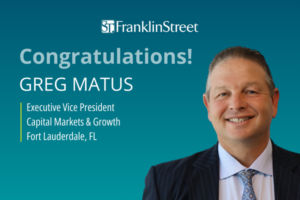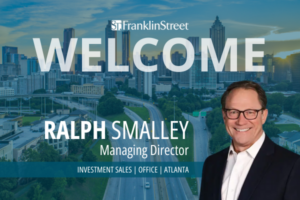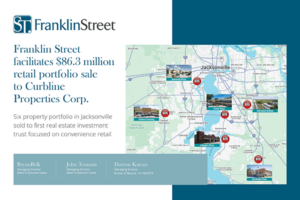The U.S. apartment market remains the most attractive property type among investors, with sales volume exceeding $32.7 billion in the second quarter of 2016, a 14 percent increase from second-quarter 2015, according to Real Capital Analytics (RCA). Sales of multifamily communities outstripped office, retail, hotel and industrial sales in the same time period for assets trading at $2.5 million and greater.
In Atlanta alone, multifamily trade volume exceeded all other commercial real estate sectors through the first half of the year — combined. Even though sales of apartment residences in Atlanta dipped 5 percent compared to the first half of 2015, roughly $3 billion of multifamily projects traded, according to RCA.
“The biggest story in our space is the sheer volume of transactions,” says Chad Thomas Hagwood, senior vice president of originations at Capital One Multifamily Finance. “That’s made up of some big deals and a ton of small- and medium-sized deals.”
The healthy investment sales performance across the United States is a product of an overall strong apartment market. According to Axiometrics, U.S. rental rates are up 4.1 percent year-todate and occupancy remains above 95 percent, despite the large amount of supply hitting the market. Through the first two quarters, 133,337 apartment units were delivered, with 521,694 units under construction as of Aug. 14.
Buoying the market is a seemingly endless base of renters who are renting by choice, a well-documented phenomenon that has dropped the homeownership rate to a 50-year low after topping out in 2004. The overall homeownership rate is currently 63.1 percent, and among young adults (under 35 years old) the rate is 34.1 percent, according to the U.S. Census Bureau.
Blake Okland, vice chairman of ARA Newmark, says the homeownership rate hasn’t reached its valley yet and doubts it will rebound anytime soon.
“We built a homeownership base for a period of time on lending practices that will hopefully never return. The renting cohort experienced a long period of time where the promise of wealth creation in homeownership was turned upside-down. They also know how homes became millstones for their parents, preventing them from taking a new job or moving,” says Okland. “The renting cohort spent years in luxury student housing projects, so they have a certain standard of living that they’ve been brought up on. They’ll spend incrementally more to stay in luxury living after college, which impacts their ability to save for a house and pay a mortgage in a more disciplined mortgage environment. This idea that the homeownership rate will somehow snap back to ‘normal’ levels pre-recession isn’t the case because it was never normal.”
Interest rates are also staying suppressed in the wake of Brexit and other global concerns, leading to more investment activity from companies wanting to take advantage of the low interest rate environment. Additionally, cap rates continue to compress at a very steady clip, signifying that prices are increasing. According to RCA, average multifamily cap rates nationwide were at 5.6 percent in the second quarter, down from 6 percent in second-quarter 2015 and 6.2 percent in second-quarter 2014.
In its Quarterly Survey of Apartment Market Conditions, the National Multifamily Housing Council (NMHC) reported that 54 percent of respondents find apartment prices to be “frothy,” meaning that buyers will be satisfied as long as the properties continue to perform. However, about 19 percent of the respondents said that prices have entered “bubble territory,” meaning they’re currently over-valued. (The survey’s respondents comprise 119 CEOs and other senior-level executives of apartment-related firms nationwide.)
The market of course sets the price, but savvy investors are worried about undisciplined or inexperienced buyers pushing prices to unhealthy levels. Managing expectations is key when brokers assist sellers in listing their properties, and Darron Kattan, managing director of Franklin Street’s Tampa office, says that it’s normal in this part of the cycle to see some unrealistic expectations.
“Owners see other properties sell and they automatically assume theirs is better, — whether it is or isn’t — and therefore they should sell for more,” says Kattan. “We’re seeing unrealistic expectations, but then again the market keeps moving and rents keep increasing so in the time that it takes a property to close the neighbor can probably raise their rents and interest rates will have decreased.”
Buyer Pool is Evolving
The RADCO Cos. is an Atlantabased multifamily investor that has purchased 61 apartment properties in the last 59 months, or roughly one community per month. The company specializes in value-add transactions in the top metros in the Southeast, namely Atlanta, Tampa, Orlando and South Carolina.
“We always look for a lower-performing project in an attractive submarket and we try to improve the operations and make the property as good as it can be, but still be what it is,” says Norman Radow, CEO of RADCO.
As an investor using a combination of private equity and bridge financing, RADCO sees plenty of competition for
Class B and C product. Value-add deals remain a hot sector for multifamily investment, and in Atlanta alone, nearly 80 percent of transactions in 2015 and 2016 have been Class B and C, according to CBRE.
Steven Shores, president and cofounder of Pollack Shores, a prominent multifamily developer and owner, agrees that competition is highest in the value-add segment with a “broad array of buyers.”
“Value-add deals seem to trade at the lowest cap rates of any product in the market, which is not historically sustainable,” says Shores. “Sellers are able to capture the economics of the value-add risk right now and leave it to the buyers to prove it up. That’s not the way it normally works.”
Value-add deals are increasing in pricing as investors are paying more for the opportunity to renovate assets, focusing more on future rents than on current income, according to Colin Gillis, vice president of acquisitions for the Southeast at Passco Cos. On the higher end of the multifamily spectrum, Shores says the buyer pool for their recently developed projects comprises mostly institutional investors.
“We have been developing in pretty unique locations and well-performing metros so we’re still seeing a lot of interest from institutions in our new developments,” says Shores. “Most of our sales have been direct to pension fund advisors or funds comprising pension, endowment and other institutional sources of capital.”
Passco Cos. is a Class A apartment investor that seeks assets in high barrier to entry submarkets within high-growth metros, such as Raleigh, Charlotte, Tampa, Nashville and Atlanta. The investment firm looks for a unique story for each asset, and it recently closed a $50.4 million purchase of The Veranda, a 236-unit property in the Louisville suburb of Prospect, Kentucky. The community was built in 2015 by Bristol Development.
“The Veranda checked every single
28 • September 2016 • Southeast Real Estate Business www.REBusinessOnline.com box for us. The property is a unique, Class A asset with very high barriers to entry that will deliver an aboveaverage return to our investors,” says Gillis.
Gillis has noticed the buyer pool is changing and the background of the companies that it bids against is evolving. Historically Class A assets are of most interest to pension fund advisors, life insurance companies, high net worth individuals, REITs and foreign entities.
“The dominant buyers of years past have slowed their appetite in the past two years. This has allowed a lot of the private capital groups, that at one time had to be ultra-aggressive in pricing and terms to compete, to have a little more flexibility in their offers,” says Gillis. “Many buyers are recognizing and asserting their leverage more than they were able to in the past.”
Simpson Housing LLLP, a privately held multifamily developer and manager, has recently purchased The Residence Buckhead Atlanta from OliverMcMillan for $136.5 million. The 370-unit property is situated within The Shops Buckhead Atlanta, a 1.5 million-square-foot mixed-use development in Atlanta’s Buckhead submarket. Simpson Housing’s purchase proves that not all buyers of Class A product in top submarkets need to be institutional investors or REITs.
The makeup of multifamily’s buyer pool has been fairly predictable over the past few years, but Okland believes that as value-add deals continue to promise a high rate of return, all bets are off.
“There is no hard and fast rule across the board between Class A and B buyers as the ebb and flow of investors seeking risk-adjusted returns can push them from one class of asset to another fairly frequently,” says Okland.
With strong competition across all segments of the multifamily spectrum, some buyers seek to differentiate themselves from the pack in order to win the bid. One of the methods that some have resorted to is contingentfree offers.
“Contingent-free offers are coming back into style. Buyers are offering up some of their deposit to not be contingent on any sort of due diligence to get their offer accepted,” says Kattan. “Those are attractive to sellers, and disciplined buyers have difficulty competing against those.”
Radow agrees, saying RADCO has trouble overcoming those offers during the bidding process: “Unfortunately as the market has gotten more competitive there are a lot of high-flying prices thrown out there that look really attractive to sellers, so some of that competitive edge that we have is lost because the numbers are so spicy and interesting to the seller.”
Investors are also expanding their investment criteria to seek multifamily projects outside of their typical target markets. In search of yield and perhaps less competition, buyers seek assets with strong fundamentals in up-andcoming markets with healthy economic indicators such as population and employment growth that can support their investment.
“The Charlottes and Atlantas are always in the headlines,” says Capital One’s Hagwood. “The interesting story is that investors are coming to the secondary and tertiary markets to buy. They’re looking for yield and the larger markets are picked over.”
Near the popular retail destination The Summit Birmingham, Nashvillebased C-H Core I LLC sold the 414-unit Colony Woods for $43 million. C-H Core purchased the asset in October 2009 for $24.8 million and upgraded more than half of the units with new appliances and lighting packages prior to the sale to Forum RE Acquisitions LLC, a multifamily investment firm based in Denver.
“The buyer pool has definitely changed in Birmingham,” says Hagwood.“It has solid fundamentals, and it’s attracted a lot out-of-state investment activity.”



